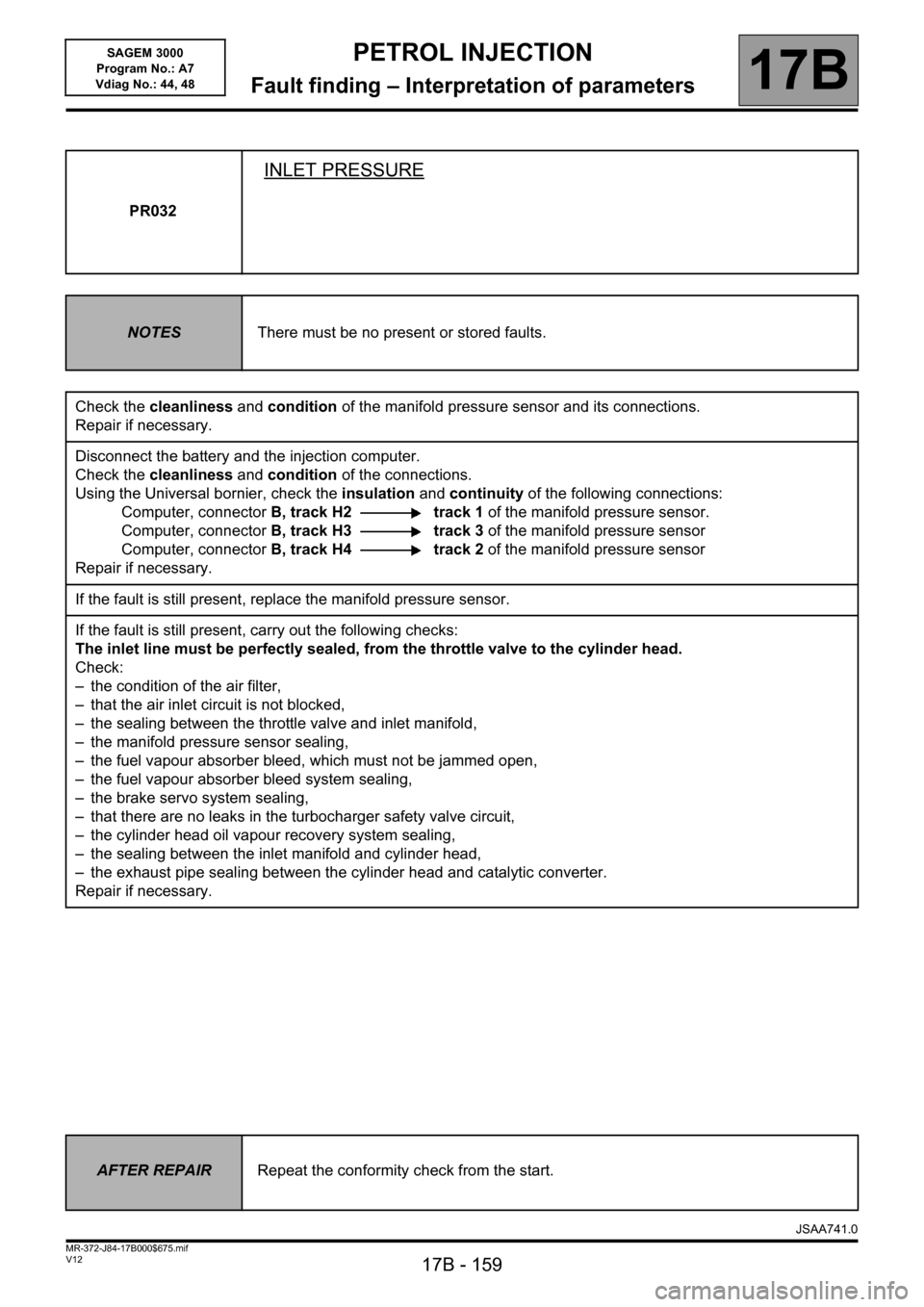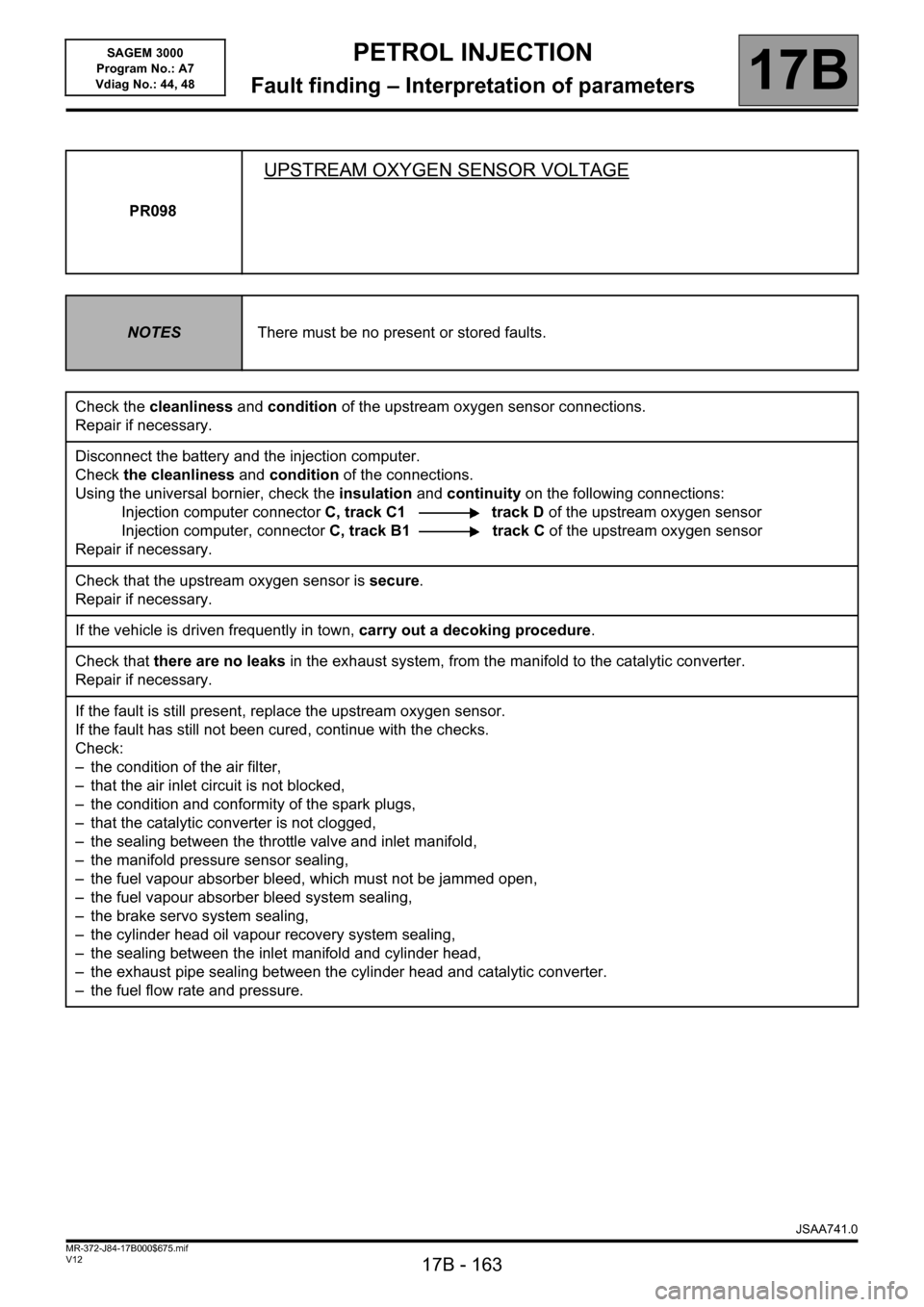2014 RENAULT SCENIC catalytic converter
[x] Cancel search: catalytic converterPage 88 of 181

PETROL INJECTION
Fault finding – Interpretation of faults17B
17B - 88V12 MR-372-J84-17B000$405.mif
SAGEM 3000
Program No.: A7
Vdiag No.: 44, 48
DF638
PRESENT
OR
STOREDLPG CYLINDER 4 COMBUSTION MISFIRE
1 DEF: Destructive misfire
2 DEF: Pollutant misfire
3 DEF: Non-compliance with emission control standards
NOTESPriority when dealing with a number of faults:
– LPG fuel system: see 17C, LPG injection,
– ignition:
DF072 Cylinder 1 ignition coil circuit
DF073 Cylinder 2 ignition coil circuit
DF074 Cylinder 3 ignition coil circuit
DF075 Cylinder 4 ignition coil circuit
– flywheel signal:
DF154 Flywheel signal sensor circuit
DF125 "Torque sensor programming"
Check whether there are other cylinders with an LPG combustion misfire fault detected
by the tool before starting the following fault finding procedure.
Conditions for applying the fault finding procedure to stored faults:
The fault appears under the following conditions:
– there must be no further electrical faults,
– the programming must have been done, particularly the flywheel target,
– warm engine (minimum 75 °C),
– run the engine at idle speed with all electrical consumers switched on for
approximately 15 minutes.
Special note:
– catalytic converter misfire: OBD warning light flashes when the fault is present then
is continuously lit,
– pollutant combustion misfire: OBD warning light lit continuously.
– engine unstable, loss of power and vibrations.
Misfiring on
cylinder 4 only
The fault is probably due to a component that can only affect this cylinder:
– check the pencil coil of cylinder 4,
– check the condition and conformity of the spark plugs,
– check the cylinder 4 LPG injector
If everything is in order, check the same components on cylinder 1 (to cover a possible
cylinder recognition error).
The fault is probably due to a component that affects a pair of cylinders:
– check the ignition coil circuit concerned (apply interpretation of fault
DF072 Cylinder 1 ignition coil circuit
DF073 Cylinder 2 ignition coil circuit
DF074 Cylinder 3 ignition coil circuit
DF075 Cylinder 4 ignition coil circuit
– check the condition and conformity of the spark plugs.
Combustion
misfires on
cylinders 1 and 4
AFTER REPAIRFollow the instructions to confirm repair.
Deal with any other faults.
Clear the stored faults.
Page 89 of 181

PETROL INJECTION
Fault finding – Interpretation of faults17B
17B - 89V12 MR-372-J84-17B000$405.mif
SAGEM 3000
Program No.: A7
Vdiag No.: 44, 48
DF639
PRESENT
OR
STOREDCOMBUSTION MISFIRE IN LPG MODE
1 DEF: Destructive misfire
2 DEF: Pollutant misfire
3 DEF: Non-compliance with emission control standards
NOTESPriority when dealing with a number of faults:
– LPG fuel system: see 17C, LPG injection,
– ignition:
DF072 Cylinder 1 ignition coil circuit
DF073 Cylinder 2 ignition coil circuit
DF074 Cylinder 3 ignition coil circuit
DF075 Cylinder 4 ignition coil circuit
– flywheel signal:
DF154 Flywheel signal sensor circuit
DF125 "Torque sensor programming"
DF059 Combustion misfire in cylinder 1,
DF060 Combustion misfire in cylinder 2,
DF061 Combustion misfire in cylinder 3,
DF062 Combustion misfire in cylinder 4.
Conditions for applying the fault finding procedure to stored faults:
The fault appears under the following conditions:
– there must be no further electrical faults,
– the programming must have been done, particularly the flywheel target,
– warm engine (minimum 75 °C),
– run the engine at idle speed with all electrical consumers switched on for approximately
15 minutes.
Special note:
– catalytic converter misfire: OBD warning light flashes when the fault is present then is
continuously lit,
– pollutant combustion misfire: OBD warning light lit continuously.
– engine unstable, loss of power and vibrations.
Check the LPG injectors.
Check the condition and conformity of the spark plugs.
Check the ignition pencil coils.
If the fault is still present, carry out the following checks:
– check the flywheel sensor,
– check the condition and cleanliness of the flywheel,
– check the flywheel sensor mounting
– check the sensor/flywheel air gap,
– check the cylinder compression's,
– check the LPG fuel system,
– check the complete ignition system (see MR 364 or 370 Mechanics, 17A, Ignition),
– check the hydraulic tappets if there is camshaft noise (see MR 364 or 370 Mechanics, 11A, Top and front of engine).
If the fault is still present, deal with the other faults, then proceed to the conformity check.
AFTER REPAIRFollow the instructions to confirm repair.
Deal with any other faults.
Clear the stored faults.
Page 140 of 181

PETROL INJECTION
Fault finding – Interpretation of statuses17B
17B - 140V12 MR-372-J84-17B000$540.mif
SAGEM 3000
Program No.: A7
Vdiag No.: 44, 48
ET054
IDLING SPEED REGULATION
NOTESThere must be no present or stored faults.
Check the parameters PR032, PR058, PR064, PR118, PR119 and PR030.
Check that all these parameters are completely correct.
IDLING SPEED
TOO LOW
Check:
– the engine oil level (too high splashing),
– that the exhaust pipe is not blocked (catalytic converter damaged),
– the cleanliness and conformity of the air filter,
– that the air inlet circuit is not blocked,
– that the throttle valve is not clogged,
– the condition and conformity of the spark plugs,
– the fuel circuit sealing,
– the fuel pressure and flow (see MR 364 Mechanics, 17B, Petrol injection),
– the condition and cleanliness of the injectors,
– the cylinder compression's,
– the timing adjustment,
– the hydraulic tappets if there is camshaft noise (see MR 364 Mechanics, 11A, Top and front of engine).
Repair the defective component if necessary.
JSAA741.0
Page 143 of 181

PETROL INJECTION
Fault finding – Interpretation of statuses17B
17B - 143V12 MR-372-J84-17B000$540.mif
SAGEM 3000
Program No.: A7
Vdiag No.: 44, 48
ET055
CONTINUED
Check:
– the condition of the air filter,
– that the air inlet circuit is not blocked,
– the condition and conformity of the spark plugs,
– the sealing between the throttle valve and inlet manifold,
– the manifold pressure sensor sealing,
– the fuel vapour absorber bleed, which must not be jammed open,
– the fuel vapour absorber bleed system sealing,
– the brake servo system sealing,
– the turbocharger safety valve circuit sealing,
– the cylinder head oil vapour recovery system sealing,
– the sealing between the inlet manifold and cylinder head,
– the exhaust pipe sealing between the cylinder head and catalytic converter.
– the fuel flow rate and pressure.
If the idling speed is not stable, check:
– the timing adjustment,
– the hydraulic tappets if there is camshaft noise (seeMR 364 Mechanical, 11A, Top and front of engine),
– the cylinder compression's.
Drive the vehicle to check the repair.
Repair the defective components.
AFTER REPAIRRepeat the conformity check from the start.
JSAA741.0
Page 159 of 181

PETROL INJECTION
Fault finding – Interpretation of parameters17B
17B - 159V12 MR-372-J84-17B000$675.mif
SAGEM 3000
Program No.: A7
Vdiag No.: 44, 48
PR032
INLET PRESSURE
NOTESThere must be no present or stored faults.
Check the cleanliness and condition of the manifold pressure sensor and its connections.
Repair if necessary.
Disconnect the battery and the injection computer.
Check the cleanliness and condition of the connections.
Using the Universal bornier, check the insulation and continuity of the following connections:
Computer, connectorB, track H2 track 1 of the manifold pressure sensor.
Computer, connectorB, track H3 track 3 of the manifold pressure sensor
Computer, connectorB, track H4 track 2 of the manifold pressure sensor
Repair if necessary.
If the fault is still present, replace the manifold pressure sensor.
If the fault is still present, carry out the following checks:
The inlet line must be perfectly sealed, from the throttle valve to the cylinder head.
Check:
– the condition of the air filter,
– that the air inlet circuit is not blocked,
– the sealing between the throttle valve and inlet manifold,
– the manifold pressure sensor sealing,
– the fuel vapour absorber bleed, which must not be jammed open,
– the fuel vapour absorber bleed system sealing,
– the brake servo system sealing,
– that there are no leaks in the turbocharger safety valve circuit,
– the cylinder head oil vapour recovery system sealing,
– the sealing between the inlet manifold and cylinder head,
– the exhaust pipe sealing between the cylinder head and catalytic converter.
Repair if necessary.
AFTER REPAIRRepeat the conformity check from the start.
JSAA741.0
Page 163 of 181

PETROL INJECTION
Fault finding – Interpretation of parameters17B
17B - 163V12 MR-372-J84-17B000$675.mif
SAGEM 3000
Program No.: A7
Vdiag No.: 44, 48
PR098
UPSTREAM OXYGEN SENSOR VOLTAGE
NOTESThere must be no present or stored faults.
Check the cleanliness and condition of the upstream oxygen sensor connections.
Repair if necessary.
Disconnect the battery and the injection computer.
Check the cleanliness and condition of the connections.
Using the universal bornier, check the insulation and continuity on the following connections:
Injection computer connectorC, track C1 track D of the upstream oxygen sensor
Injection computer, connectorC, track B1 track C of the upstream oxygen sensor
Repair if necessary.
Check that the upstream oxygen sensor is secure.
Repair if necessary.
If the vehicle is driven frequently in town, carry out a decoking procedure.
Check that there are no leaks in the exhaust system, from the manifold to the catalytic converter.
Repair if necessary.
If the fault is still present, replace the upstream oxygen sensor.
If the fault has still not been cured, continue with the checks.
Check:
– the condition of the air filter,
– that the air inlet circuit is not blocked,
– the condition and conformity of the spark plugs,
– that the catalytic converter is not clogged,
– the sealing between the throttle valve and inlet manifold,
– the manifold pressure sensor sealing,
– the fuel vapour absorber bleed, which must not be jammed open,
– the fuel vapour absorber bleed system sealing,
– the brake servo system sealing,
– the cylinder head oil vapour recovery system sealing,
– the sealing between the inlet manifold and cylinder head,
– the exhaust pipe sealing between the cylinder head and catalytic converter.
– the fuel flow rate and pressure.
JSAA741.0
Page 165 of 181

PETROL INJECTION
Fault finding – Interpretation of parameters17B
17B - 165V12 MR-372-J84-17B000$675.mif
SAGEM 3000
Program No.: A7
Vdiag No.: 44, 48
PR099
DOWNSTREAM OXYGEN SENSOR VOLTAGE
NOTESThere must be no present or stored faults.
Check the cleanliness and condition of the downstream oxygen sensor connections.
Repair if necessary.
Disconnect the battery and the injection computer.
Using the universal bornier, check the insulation and continuity on the following connections:
Injection computer, connectorC, track A2 track D of the downstream oxygen sensor
Injection computer, connectorC, track B2 track C of the downstream oxygen sensor
Repair if necessary.
Check that the downstream oxygen sensor is secure.
Repair if necessary.
If the vehicle is driven frequently in town, carry out the unclogging procedure (oxygen sensors and catalytic
converter clogging).
Check that the exhaust pipe is completely leak free.
Repair if necessary.
Replace the downstream oxygen sensor.
If the fault is still present, the catalytic converter is certainly damaged.
If the catalytic converter is defective, determine the cause of the destruction, otherwise the new catalytic
converter may be damaged in turn.
Remove the catalytic converter.
Possible reasons for the destruction of a catalytic converter:
–deformation (impact),
–thermal shock (cold water splashed onto a hot catalytic converter can damage it),
–defective injector or ignition: the catalytic converter is damaged by contact with fuel (coil fault, coil control fault,
injector jammed open),
–injector leak,
–abnormal oil or coolant consumption (defective cylinder head gasket),
–use of a fuel additive or other equivalent product (obtain information from the customer because this type of
product can contaminate the catalytic converter and render it useless sooner or later).
Look up the service history of the vehicle or, if this is not possible, ask the customer if the vehicle has had injection
or ignition faults.
If the cause of the catalytic converter damage has been found and the fault has disappeared, replace the
catalytic converter.
AFTER REPAIRRepeat the conformity check from the start.
JSAA741.0
Page 166 of 181

PETROL INJECTION
Fault finding – Command summary table17B
17B - 166V12 MR-372-J84-17B000$720.mif
SAGEM 3000
Program No.: A7
Vdiag No.: 44, 48PETROL INJECTION
Fault finding – Command summary table
Tool commands Diagnostic tool title
SC006Start OBD test: catalytic converter
SC007Start OBD test: O
2 sensors
RZ001Fault memory
RZ005Programming
AC004Turbocharging solenoid valve
AC015Fuel pump relay
AC017Canister bleed solenoid valve
AC018Upstream O
2 sensor heating
AC019Downstream O
2 sensor heating
AC027Motorised throttle
VP008Unlock injector command
VP010Enter VIN
VP013Lock injector command
JSAA741.0
MR-372-J84-17B000$720.mif